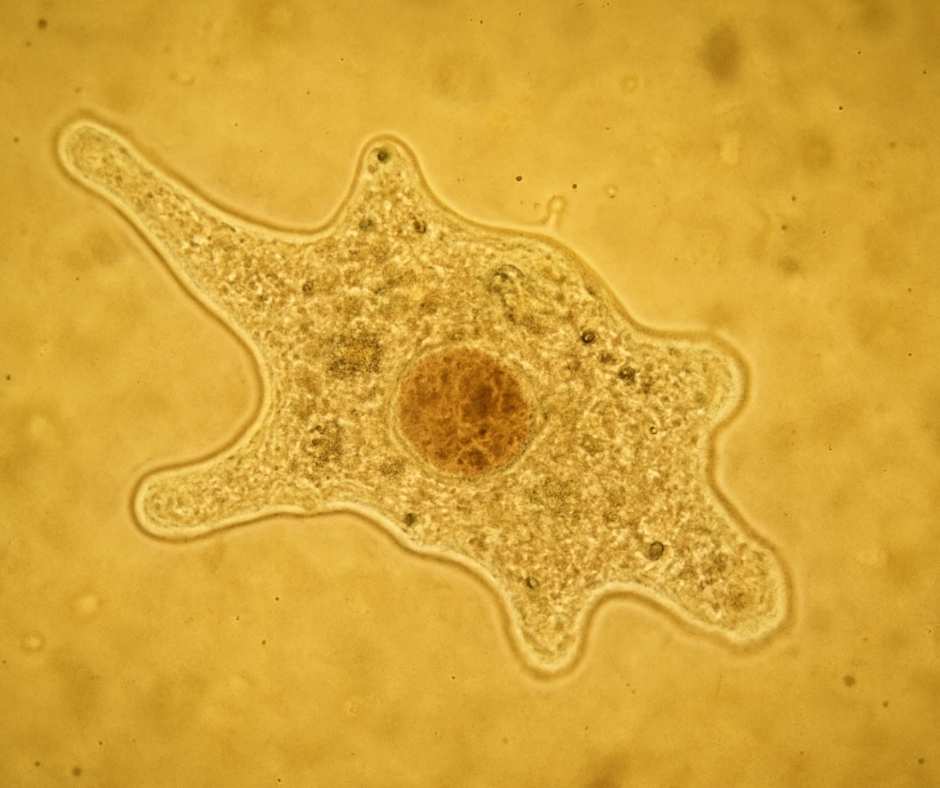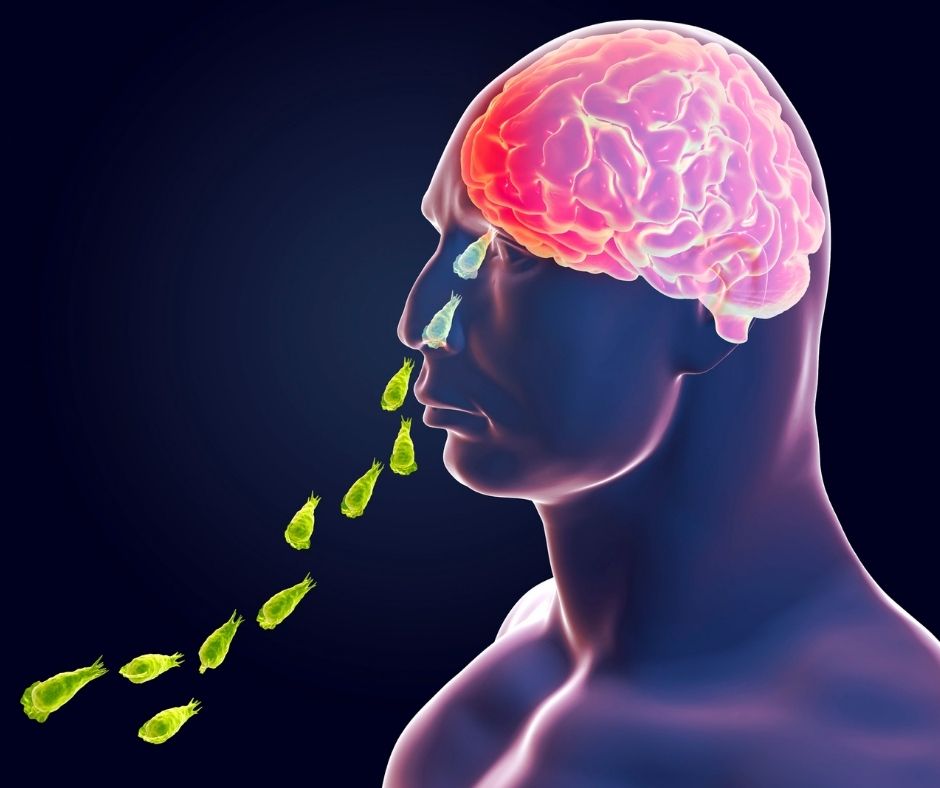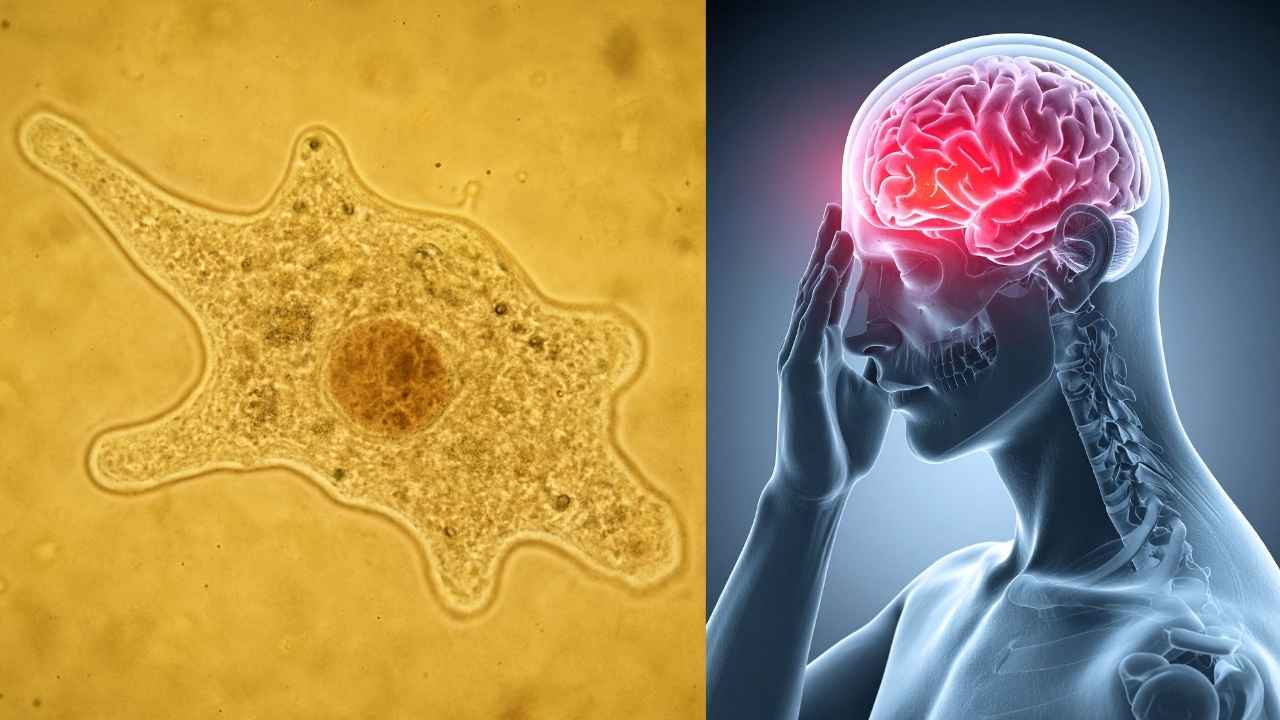The recent surge of brain eating amoeba in Kerala has raised serious public health concerns, with multiple confirmed cases and tragic fatalities reported across the state. As per the latest update, 19 people died and several other people are suffering from this amoeba infection. This rare but deadly infection, caused by Naegleria fowleri, has a fatality rate of nearly 97%, making awareness, early diagnosis, and preventive safety measures critical. In this article, we will explore the symptoms, diagnostic tests, available treatment options, and necessary safety precautions to help people stay informed and protected.
Table of Contents
What is Brain Eating Amoeba?

Brain-eating amoeba refers to Naegleria fowleri, a free-living amoeba typically found in warm freshwater sources such as lakes, rivers, ponds, and poorly maintained swimming pools. While harmless if swallowed, the amoeba becomes dangerous if it enters the human body through the nose, usually during swimming or water-related activities. From there, it travels to the brain, causing a rare but devastating infection called Primary Amoebic Meningoencephalitis (PAM).
Globally, only about 20 documented survivors exist despite decades of medical advancements, highlighting the seriousness of the infection.
Related news: Delhi-NCR Gripped by H3N2 Flu Surge: Symptoms, Risks & Prevention
How Does the Infection Spread?
The infection does not spread from person to person. Instead, it occurs when contaminated water enters the nasal cavity. Once inside, the amoeba migrates along the olfactory nerve to the brain, where it begins to destroy tissue, triggering inflammation and neurological damage.
Risk factors include:
- Swimming or diving in warm freshwater lakes, rivers, or ponds.
- Using untreated tap water for nasal rinsing.
- Exposure to poorly chlorinated swimming pools or water parks.
Health Awareness: Blood Cancer Awareness Month 2025
Symptoms of Brain Eating Amoeba Infection
The symptoms of Naegleria fowleri infection often appear within 1–12 days of exposure and progress rapidly. Early recognition is essential for timely treatment.
Initial symptoms:
- Severe headache
- Fever
- Nausea and vomiting
Advanced symptoms:
- Stiff neck
- Confusion or hallucinations
- Seizures
- Loss of balance
- Sensitivity to light
- Coma in later stages
Since these symptoms mimic bacterial or viral meningitis, misdiagnosis is common, leading to delayed treatment.
Awareness: Heart Disease Symptoms, Cardiologist-Recommended Tests, Treatement & Natural Care
Tests and Diagnosis
Early and accurate diagnosis remains one of the biggest challenges in managing brain-eating amoeba infections. Standard laboratory tests often fail to detect the amoeba in time.
Diagnostic approaches include:
- Cerebrospinal fluid (CSF) analysis: Detects the presence of amoeba in spinal fluid through microscopic examination.
- PCR (Polymerase Chain Reaction): A molecular test that can identify Naegleria fowleri DNA.
- Brain imaging (MRI or CT scan): Helps detect inflammation and brain swelling, though it cannot directly confirm the amoeba.
- Culture methods: Growing the organism in specialized labs for confirmation.
Because of the rapid disease progression, diagnosis must be swift and accurate for any chance of survival.
Career option: Join Our Government-Approved Paramedical DRD Course
Treatment Options
Treating brain-eating amoeba infection is extremely difficult, but recent medical advancements offer some hope.
- Miltefosine: Initially developed as an anti-cancer and anti-leishmaniasis drug, it has shown promise as a frontline therapy against Naegleria fowleri.
- Amphotericin B: A broad-spectrum antifungal drug traditionally used in treatment. It may be administered intravenously or intrathecally (directly into the spinal canal).
- Combination therapy: Miltefosine is often used alongside Amphotericin B, rifampicin, azithromycin, and fluconazole to increase effectiveness.
- Supportive care: Managing brain swelling, seizures, and respiratory function in an intensive care setting is critical.
- Experimental therapies: Some cases have used induced hypothermia (cooling the body) to reduce brain inflammation and improve survival odds.
Despite these treatments, survival rates remain low, underscoring the need for early intervention and prevention.
You may know about: The Effects of Dehydration: Symptoms, Diseases, Tests, and Prevention
Safety and Preventive Measures
Since the infection is almost always fatal once symptoms develop, prevention remains the most effective strategy.
Safety tips to reduce risk:
- Avoid swimming or diving in warm freshwater during hot weather.
- Use only sterile, boiled, or filtered water for nasal rinsing (e.g., during religious practices like jal neti).
- Keep swimming pools properly chlorinated and maintained.
- Avoid disturbing sediment in lakes or rivers, as it may release amoeba.
- Always use nose clips or keep your head above water when swimming in freshwater sources.
Authorities in Kerala have also urged citizens to remain cautious during water-based activities, particularly in districts where cases have been reported.
Related: What is Frontotemporal Dementia? Understanding Bruce Willis’ Diagnosis
Public Health Response in Kerala
Kerala has seen a surge of cases in recent weeks, with confirmed deaths and a few rare recoveries. Health authorities have ramped up surveillance, issued public advisories, and urged citizens to avoid swimming in freshwater bodies. Public health campaigns stress the importance of awareness, as early detection remains the only chance for survival.
Top doctors across India have echoed similar warnings, urging people to remain vigilant, especially during the monsoon when water sources become warmer and stagnant.
You should know: Why Regular Check-ups during Pregnancy Is Essential?
Why This Infection is So Challenging
The challenge with brain eating amoeba infection lies in its rarity, rapid progression, and lack of widespread awareness. Many doctors may not immediately consider Naegleria fowleri when a patient presents with meningitis-like symptoms, causing critical delays in treatment.
Adding to the problem is the amoeba’s resistance to many standard drugs, making treatment success rare even with aggressive therapies.

The case fatality rate of 97% makes it one of the deadliest infectious diseases known to humans.
Discovery: The Cancer Sugar That May Help Cure Type 1 Diabetes
What to Do If Symptoms Appear
If someone develops sudden onset of severe headache, fever, or confusion after freshwater exposure, immediate hospitalization is critical. Patients should:
- Report any history of freshwater swimming to doctors.
- Insist on urgent CSF analysis and PCR testing for Naegleria fowleri.
- Begin treatment with miltefosine and combination therapies as soon as possible.
Related: What is Lyme Disease? The Illness That Justin Timberlake Was Diagnosed With
Conclusion
The outbreak of brain eating amoeba in Kerala serves as a reminder of how deadly and fast-progressing rare infections can be. While cases are relatively few compared to other diseases, the high fatality rate and lack of effective treatment options make it a public health concern. Awareness, preventive safety measures, and rapid medical intervention remain the most effective defenses against this dangerous infection. Staying alert, cautious, and informed can save lives.
Scientific References
- Centers for Disease Control and Prevention (CDC). “Naegleria fowleri – Primary Amebic Meningoencephalitis (PAM).”
- Visvesvara, G.S., Moura, H., & Schuster, F.L. (2007). “Pathogenic and opportunistic free-living amoebae: Naegleria, Acanthamoeba, Balamuthia, and Sappinia.” FEMS Immunology & Medical Microbiology.
- Capewell, L.G., Harris, A.M., Yoder, J.S., et al. (2015). “Diagnosis, Clinical Course, and Treatment of Primary Amoebic Meningoencephalitis in the United States, 1937–2013.” Clinical Infectious Diseases.
- Cope, J.R., Ali, I.K.M. (2016). “Primary Amebic Meningoencephalitis: Epidemiology and Diagnostic Challenges.” Current Infectious Disease Reports.
Related news sources: The Hindu, Times of India, NDTV
